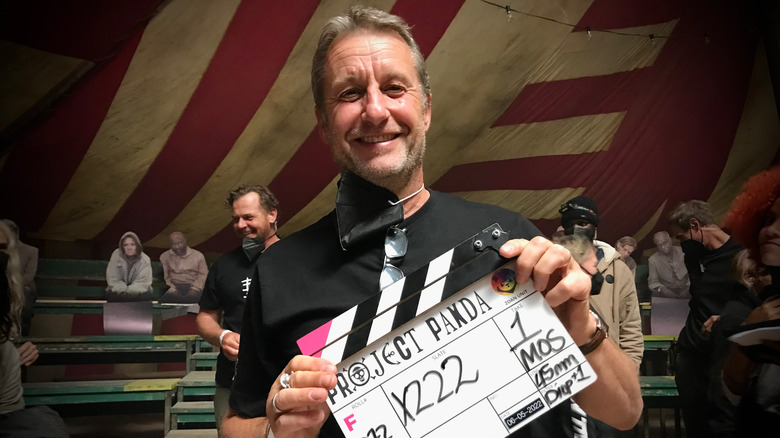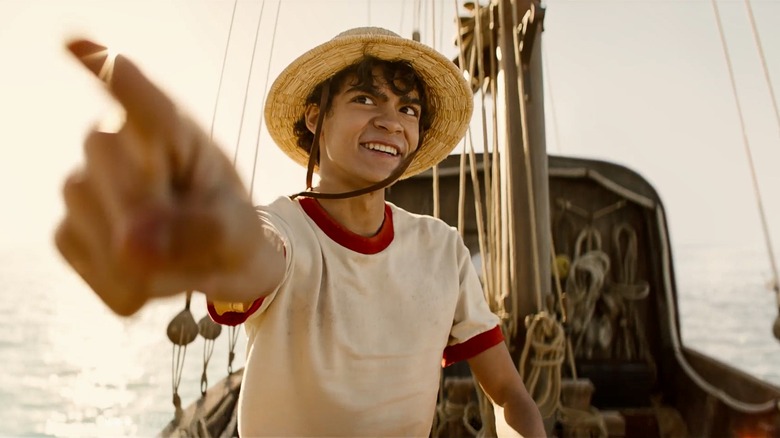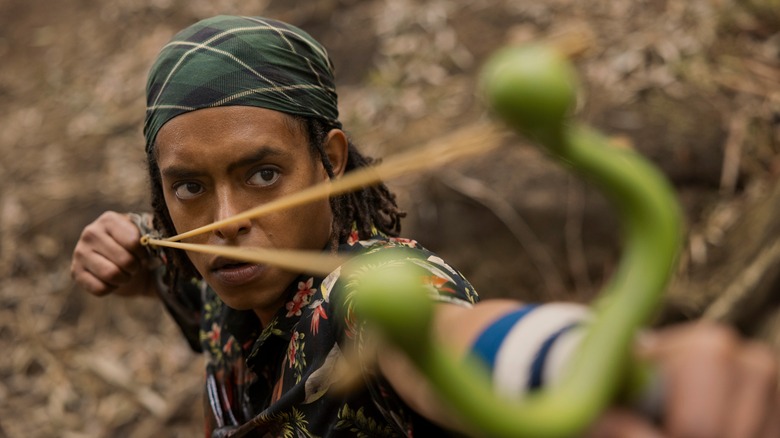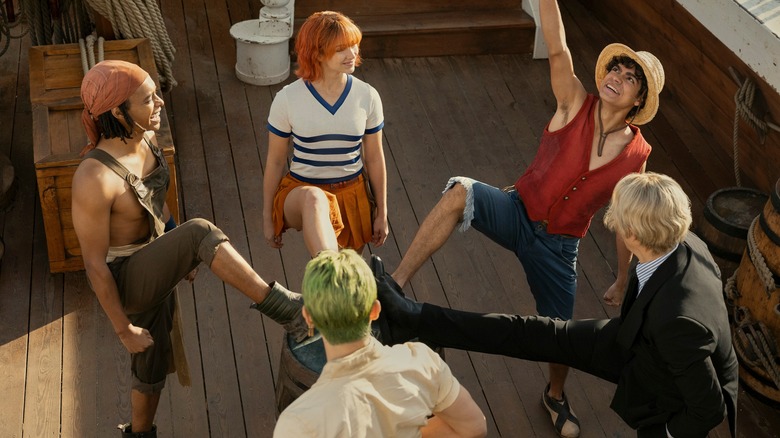One Piece: Marc Jobst Explains The Key Difference Between The Live-Action Show And Marvel - Exclusive Interview
Director Marc Jobst is no stranger to big budget Netflix series. Not only has he helmed episodes of "The Witcher," but he's also directed several Marvel Television shows, including "The Punisher," "Luke Cage," and "Daredevil." It seems only fitting that he'd be involved in Netflix's eight-episode live action adaptation of the wildly popular manga series "One Piece," which premieres on the streaming service on Aug. 31.
"One Piece" follows the adventures of a young pirate named Luffy (played by Iñaki Godoy) who sets out with his Straw Hat crew to find the mythical treasure known as the One Piece and be crowned the new Pirate King. The original manga series, created by Eiichiro Oda, has been in production since 1997 and has become the all-time best-selling manga series, with over 500 million copies sold worldwide. Needless to say, a lot of people are waiting to watch the new live-action version.
During an exclusive interview with Looper, Jobst — who directed the first two episodes of the new series — delved into what it took to bring "One Piece" to life, how he incorporated what he learned on Marvel sets into the show, and why the story of Luffy and the Straw Hat pirates is exactly what the world needs right now.
One Piece is more 'playful and optimistic' than Marvel
You've been on several Marvel Television sets — "Daredevil," "Luke Cage," and "The Punisher." How did being on the "One Piece" set stack up to those experiences?
Thank heavens I'd done all the Marvel shows before I did the "One Piece," because I learned so much shooting those shows. They're very demanding. They've got loads of drama and proper acting work and huge action sequences and all the rest of it. I come from theater, so I'm used to working with actors. I love working with actors. They are your biggest tool when you are telling a story in theater. The working-with-actors side of things was always something that I loved.
On "One Piece," I was working with young actors who were not necessarily hugely experienced — Iñaki [Godoy] in particular, who is playing Luffy. That was something that I ran to and embraced, because it's such a privilege to work with talent who are excited and keen and work hard and want to learn and want to give their best.
There was one fundamental difference, which is that Marvel shows are pretty visceral. It's gritty, it's dark, it's sweaty, it's bloody, it's painful, it's adult. I didn't feel like that was the case with "One Piece." "One Piece" is much more playful than that. It's sunny, it's optimistic, it's full of hope and belief, belief in your dreams and all those things.
We needed to find a different energy on the set. We needed to find a different energy when shooting the action sequences and in how the actors were [handled]. [Showrunners] Steve Maeda and Matt Owens' scripts already provided a huge opportunity for me as a director to take the show in that direction, but fundamentally, you are always asking the same questions, which are: "What's the story? Who are the characters and what do they want?" That's whether you're doing the Marvel shows or "One Piece." Tonally, though, "One Piece" had to be its own thing, because "One Piece" is so unique.
A special lens was used to capture the essence of One Piece
When adapting such a long-running, beloved series as "One Piece" to live action, what was your main focus in terms of getting things right?
You are essentially trying to turn a two-dimensional world and two-dimensional drawings into a three-dimensional world in which you put real human beings who have emotions and boundaries to their own physicality. Our biggest thought was to make sure that we dimensionalized the characters, that we gave them full emotional lives, backstories, desires, wants, frailties, all those things that a human being has. If we try to replicate two dimensions, it becomes unbelievable, and the audience can't really relate to it.
One of the biggest things I felt that we wanted to do was cast it and create characters that the audience would fall in love with. An audience doesn't fall in love with the world [we created]. They fall in love with the people. Matt and Steve's strips were so strong on character — and story, and backstory — that if we cast it right and made sure we got people that we love to watch, that we can relate to, then I felt we were a good way down the road.
The second thing is, as a director, when you look at the manga and you look at the framings of the manga, you think, "How do we bring some of those low angles of the foot coming down into the front of the frame, or one-eye shots, into live action and make it feel grounded and real?" That's why we got these special lenses built for us in Germany that had never been used before. They were super-close focus, but also very wide. That's what gives the show a particular look and allows the audience to be with the characters all the time, to travel with them while still seeing the world.
Do you have any favorite Easter eggs you can share from the two episodes you directed?
If I say what my favorite Easter egg is, then it no longer becomes an Easter egg.
Fair enough. Any favorite moments from the set you can share?
There are two things that I would pull out from the pilot. The big fight sequence in the courtyard is huge. It's a very long fight. It's broken into three acts, and it's lovely because it brings the three characters together for the very first time. It was a complicated fight to shoot, but what Franz Spilhaus, the designer of that fight sequence, did in his choreography — and what we were able to do and how we then shot it — made us able to create a fight sequence that felt real and dangerous, but also had a joy to it. That was the tone that we were trying to bring all the time.
The second piece that I'd like to pull out is the little scene between Luffy and Koby in the boat when Luffy is talking to Koby. I felt like it had everything that I loved about Matt and Steve's scripts. There was the epic of that big fight. Then, you had the intimacy of this lovely conversation between Luffy and Koby. When I saw those two actors work together in that scene and I saw the warmth and the chemistry that existed, I thought, "I really think this can work."
Jobst found the One Piece scripts to be inspirational
Were you a fan of "One Piece" before taking on this project? Whether you were or not, what do you hope audiences get out of this series?
No, I wasn't particularly. I knew of its existence. I knew both the manga and the anime, but wasn't really [familiar with it] until the studio phoned me up to ask if I would be interested in coming to talk to them about it. I read the scripts and thought, "This is really special," and the actors that came in to audition would say, "You have no idea how much this means to me. This has seen me through some really dark times."
As a director, you're coming into a show that has got action and it's got scale and it's got intimate moments of real character insight — and it's a pirate show. It's about something. It's about following your dreams. It's about believing in yourself. It's about being loyal to each other, being loyal to our friends, because sometimes our friends are more family than our blood family, and that's okay. It's about Luffy inspiring everybody to be themselves and to be more of themselves.
Whilst I didn't know what "One Piece" was in particular, I thought, "We need this in the world right now. We need this kind of energy, this kind of hope, and this kind of spirit." I fell in love with it, and I hope that the fans who love the manga and the anime will fall in love with the actors and the characters and that the world that we've created will stand alongside the others and inform and build their love for the anime and the manga, and vice versa. For those who don't know anything about "One Piece," I hope they step onto these boats with these guys and come on an adventure.
What's next for you? I know the writers' and actors' strikes have put things on hold, but anything in the pipeline? Any chance you'll be involved in the "Daredevil" reboot when it happens?
I don't know about "Daredevil," to be honest. "One Piece" has been so absorbing. I haven't really followed up with Charlie [Cox] and Vincent [D'Onofrio] and Jon [Bernthal], so I'm not quite sure what the Disney take on it is. I'm sure it'll be fantastic, though, because Charlie and Vincent and Jon wouldn't sign up if it wasn't.
Otherwise, I'm writing and directing a movie about homelessness. It's about three homeless kids that use rap, beatbox, and movement and dance to tell a story about what a home is. I'm also a director on a World War II film — a very different story [for me] set at the end of the second World War, which I'm rewriting at the moment before we go into production. Plus, I'm hoping that "One Piece" goes on to Season 2.
Marc would like to state that he supports both SAG and WGA in their pursuit of reaching a fair and equitable resolution to the respective strikes. In talking about his work — past and present — he does so with unequivocal support for the highly skilled crews that make up the different unions (SAG and WGA included) and believes all should be valued and recompensed for the contributions they make in bringing these series and films to life.
"ONE PIECE" is a live action pirate adventure created in partnership with Shueisha and produced by Tomorrow Studios and Netflix. Matt Owens and Steven Maeda are writers, executive producers, and showrunners. Eiichiro Oda, Marty Adelstein, and Becky Clements also executive produce. All eight episodes of the live-action adaptation of "One Piece" premiere August 31 on Netflix.
This interview has been edited for clarity.



